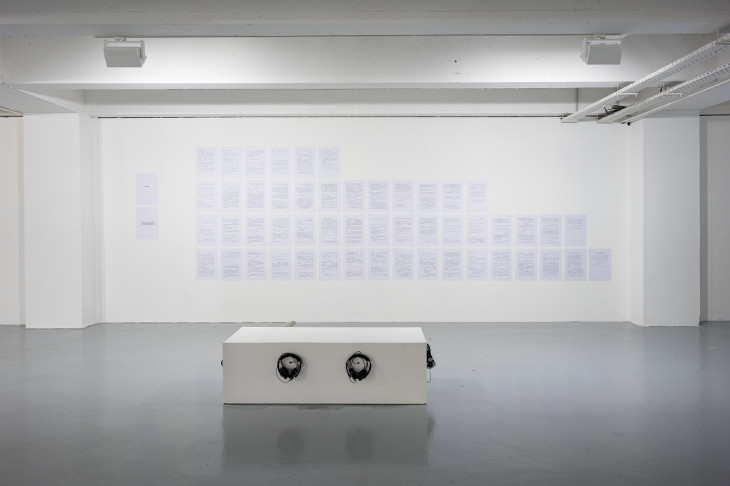The Intolerable Straight Line
Julia E. Dyck, Some Words, 2019
Score: 53 digital prints on paper, Audio: 4 .wav files through headphones (Simon.wav, Azahara.wav, Roz.wav, Maud.wav)
The following is an interview with the artist conducted by Mathilde Vaillant.
I have the impression that you are more used to working with your own music or performative compositions. What does it mean for you to work from recordings of texts, discourses that are not yours? (If I understood correctly, you are going to transcribe interviews from other people)
In this project I’ve given myself a remarkably uncreative role and I’m definitely claiming much less authorship than I have in previous projects. The content comes from community radio archives, I used John Cage’s method of notation, and the notations were then interpreted by other performers. My performance in this work was really the act of listening to an archive and the transcription and notation of these interviews. This labor disappears as part of the production process. In a way, this is in contrast to the way my performances or compositions are often presented; my work is always an accumulation of research, conversations, and recordings, which become invisible in the final presentation.
I’m interested in questioning the idea of the artist or composer and the role of creator. We tend to like to reduce things down to singular authorship or give individuals status of genius or virtuosity while I believe art especially is the product of an accumulation, co- creation or community. It’s a much more messy and complex story than one person having a brilliant idea, and this kind of challenges the structure of knowledge production.
Since this work was also created in the context of collective research on themes of time and trajectory, it felt appropriate to activate this radio archive of which I am actually quite implicated in. The XX Files radio show was started in 1996 by an artist run centre for feminism and digital art in Montreal called Studio XX. I joined the show as a host and producer in 2015 and still contribute monthly from a distance as I’m currently living away from Canada. I’ve revisited these archives so many times over the last few years and it’s been a huge source of inspiration for my practice. I also often think about the possibility of people listening back to the shows I’ve produced in ten or so years. I find it both humbling and exciting to be a part of this legacy or lineage, it requires a sense of accountability to the past and the future.
How do you think the position of the spectator, of the visitor of the exhibition who arrives at the end of the “Chinese Whispers” process that this installation activates? (oral interview > transcription > new recording > broadcasting > reception by the audience).
I think the position of a visitor or spectator of any artwork is inherently only receiving a mediated message and their experience is always subjective. It’s this subjective and relational position of listening that really interests me in general. I’ve been thinking about this piece as a kind of echo – a phenomenon where the source is unheard and is being altered through repetition, variation, development, and rupture. By notating something as ephemeral as a live community radio interview, I’m amplifying it by drawing attention to every word, utterance, pause, and hesitation, while simultaneously reducing it to black and white text on paper. Through the interpretation of the score by performers, these conversations are reflecting off another subject and, again, loose something while gaining another resonant quality. This difference and dissonance, in contrast to an identical reflection, is really interesting to me in terms of re-evaluating the subject-object relation.
How did you choose the interviews that you work from in this exhibition? Is the topic that they discuss important to you or is it the rhythm of the spoken language that counts? (or both?).
I had a few things in mind while choosing which interviews to work with; I wanted to use interviews with artists who are still active and whose practices resonate with mine, and I chose to work with the first ten years of the archive (1996-2006). I was focused more on content than on the rhythmic quality of speech but incidentally; I ended up with a really dynamic group of voices and speech patterns. Almost all of the artists also mentioned being influenced and inspired by other Canadian women artists, so this was a nice surprise and further reinforced this idea of networked and collective trajectories.
An interview conducted by Mathilde Vaillant (seminar “Listening to the Archives”, Master of Fine arts, Université Rennes 2).


